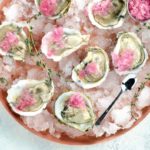Oysters with Mignonette Granita
Mignonette granita is a fun, visually stunning riff on the classic mignonette sauce that often accompanies oysters on the half shell. Serve this condiment on a platter of freshly shucked oysters. (Learn to shuck from the accompanying video — it's easier than you think.)
Calories: 51kcal
Ingredients
- ½ cup (120 ml) red wine vinegar
- 1 small shallot minced
- 5 peppercorns crushed
- ¼ teaspoon fine sea salt
- ¼ teaspoon sugar
- 1 dozen oysters
Instructions
To make the mignonette granita
- Combine all ingredients in a very small pot. Bring mixture to a boil over medium heat. Boil for 30 seconds, then remove from heat and let cool completely.
- Pour cooled mixture through a fine-meshed sieve into a small baking dish or other freezer-safe container just big enough to hold the mixture in a shallow layer. (Protip: save the strained shallot and toss into your next salad.)
- Freeze the mixture, scraping every hour or so with a fork to break up the ice into small pieces, until fully frozen (probably about 3 hours).
- Serve in a small, very cold bowl as a condiment for oysters on the half shell.
To clean and shuck the oysters
- Start by cleaning the shell thoroughly, using a firm-bristled brush under cold running water to remove all grit from the exterior. There will inevitably be a bit of sand trapped in the hinge, which you'll encounter while shucking — there's nothing you can do about it at this stage, so when you find it later, know that you haven't done anything wrong.
- First you'll identify the top and bottom of the oyster. The top shell is flat, and the bottom is cupped. This is more obvious on some oysters than others, but there's always at least some difference between top and bottom. Orient the oyster right-side-up so you won't lose the delicious liquor inside when you open it.
- Then you'll find the hinge and insert the tip of the knife into it. You'll need to use a combination of knowledge and strength to identify exactly where and how far to insert — you'll quickly get a feel for it as you practice.
- Once the knife is inserted far enough to create a useful lever that will open the shell rather than chipping off bits of it, you'll give the handle a good, strong twist to pop the hinge open. This is where you'll encounter an extra bit of grit, so wipe the tip of the knife clean on your towel before proceeding.
- Insert the clean knife tip between the top and bottom shells near the opening you created, and run it all the way around the edge to loosen the top shell from the bottom.
- Detach the oyster from the top shell by scraping the muscle with the knife, and discard the top shell.
- Then use the knife to detach the oyster from the bottom shell, too. Do your best to keep it level so you won't spill too much of the liquor.
- Place prepared oyster on a platter filled with crushed ice.
Video
Notes
- You can make the mignonette granita far in advance if you like. Keep it frozen in an airtight container for up to three months.
- Oysters that have just been harvested can be stored, unopened, in a nice cold fridge for up to a week. Always buy from a trusted supplier.
- Shuck oysters shortly before serving and keep on ice.
Nutrition
Serving: 1 | Calories: 51kcal | Carbohydrates: 4g | Protein: 5g | Fat: 1g | Polyunsaturated Fat: 1g | Cholesterol: 25mg | Sodium: 98mg
